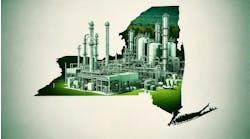An electrical system comprises sub-stations with transformers, busways, switchgears, panel boards and actual electricity consumers. The electricity consumers convert the electricity into useful output, such as motion, heat, light, sound or ionizing chemical solutions. Motion conversion systems, commonly referred as motor-driven systems, are the largest electricity consumers. The U.S. industrial sector consumes more than 700 billion kWhs of electricity and spends over $30 billion annually to drive its electrical motors.
[pullquote]
Electrical energy cost control starts with the utility contract itself. Because electricity can’t be generated in advance or stored in large quantity, most utility companies offer very low tariffs during off-peak times such as at night when most non-industrial users stop consuming electricity. Hence, process engineers can review their electrical loads and consider shifting some of the load to low-cost, off-peak power, if possible. Plants operating large chillers can take advantage of these off-peak, low-tariff offers by installing thermal storage systems to shift chiller operations to off-peak hours. Large water-storage pumps and batch-operated wastewater treatment plants also are good candidates for shifting to off-peak hours.
Most plants pay a significant portion of their electricity bill as maximum demand charges, calculated based on the peak consumption rate (peak demand) at any 30-minute period in the monthly billing cycle. In many processing plants (especially batch operations), the average electricity demand isn’t even 65% of the peak demand in each billing cycle. It’s possible to reduce peak demand by properly scheduling processing operations. The process engineer, electrical engineer and the operations staff collectively should work out the scheduling. If possible, stagger some electrical loads, especially simultaneous startups (an electrical motor’s startup current typically is six times higher than the normal running current). The current consumption of each electrical load directly impacts the maximum demand of the plant’s electrical system.
Another component that impacts maximum demand is the power factor. In simple terms, power factor is the multiplier to evaluate the true load from the actual demand. Because AC induction motors are the largest electricity users in most plants, the power factor goes down due to the reactive load and the demand increases, even though the true power consumption is lower. Some utilities even impose a penalty if the recorded power factor is lower than 0.9 in a billing cycle. Because inductance and capacitance in an electrical circuit create reactive loads in the opposite direction, lower power factors caused by induction motors can be corrected by adding capacitor banks. In many plants, reducing maximum demand charges alone can justify the investment to add capacitor banks .
Electrical motors account for a large share of electricity consumption. Motor controls comprise sensors, switches, timers, relays and other devices for automatically operating a motor to a pre-set criterion. For example, a motor that runs a pump must start when the discharge-side pressure falls to a minimum set point and stop the motor when the pressure rises to a maximum set point. A motor control circuit using pressure switches and relays can control this action automatically. This type of motor control is called simple on-off control.
For smaller-size electrical-motor-driven applications, on-off type controls can save considerable electricity use. Similar opportunities exist in plants where multiple pumps maintain the process water or cooling water systems. The on-off control also can optimize electricity use in conveyor belts and bucket elevators by minimizing operation in empty conditions. Pumps at condensate collection tanks, or pumps at any vessel that has a level controller, also save energy and reduce deterioration of pump life with the help of on-off controls. These controls provide similar energy-saving results to occupancy sensors in offices, photocells in outdoor lights and thermostats in electrically heated process furnaces. A variety of devices can be used and motor-control circuits can be made to reduce motor-driven equipment electricity use.
Electricity-consuming equipment that is of older design, poorly maintained, improperly sized or not optimally controlled, tends to use too much electricity or use it inefficiently. So, it’s worthwhile to look at the operating condition of the motor-driven equipment in addition to the motor’s efficiency. More cost-reduction opportunities in electrical system will be discussed in the next energy column.
VEN V. VENKATESAN is Chemical Processing's Energy Columnist. You can e-mail him at [email protected]



